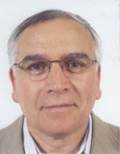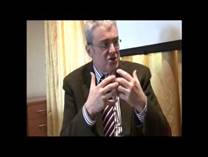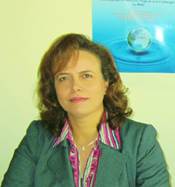Invited Speakers
| S1: Informatization and iconomy S2: A Socio-Technical Approach to International Cyber-Security S3: Visualization and Research Reproducibility? S4: Smart Cities Technologies, Opportunities and Challenges S5: Generative-Discriminative Based Methods for Arabic Recognition S6: TBA S7: Frugal Social Sustainable Casablanca Smart City: new concept to promote socio economic growth and equity in emerging countries |
|
[Abstract] From 1975 onwards the technical system, previously built on the synergy of mechanics, chemistry and energy, was supplanted by a technical system that is dominated by the synergy of electronics, software and the Internet. The institutions, especially businesses, are then entered a transitional phase: their organization is destabilized, their mission is reformulated. The current economic crisis is due to the inadequate behavior of institutions, consumers and States to the "new nature" that informatization let emerge. To get out of a crisis, you have to know where to go. We must therefore steer the strategy, taking as reference the model of a society and an economy which are by assumption mature and therefore, as economists say, efficient. We call this model iconomy. It shows the necessary conditions of efficiency: a society that does not respect them can not reach the efficiency in the new technical system. Here are its main results: In total, the iconomy is an economy of quality, competence and risk. This model illuminates the present situation: . [Biography] . |
|
[Abstract] Studying international aspects of cyber security requires taking into account both technical and social dimensions. However, the majority of cyber security research has only focused on the technical dimension. In my work, I study international cyber-security using a socio-technical approach that combines data science techniques, computational models, and network science techniques. [Biography] Ghita Mezzour is an Assistant Professor at the International University of Rabat. She received her Ph.D. degree from Carnegie Mellon University (CMU) in the United States in May 2015. At CMU, she was part of both the School of Computer Science and the Electrical and Computer Engineering Department. Her research interests are at the intersection of cyber security, big data, and socio-technical systems. She holds a Master and a Bachelor in Communication Systems from the Ecole Polytechnique Fédérale de Lausanne in Switzerland. |
|
[Abstract] Nowadays, running tests and visualize simulations becomes an essential part of scientific
findings validation and experimentation. It becomes crucial to researchers to
launch simulations and scripts to evaluate and test their models and algorithms
on computer platforms. However, research dissemination methods suffer from a
major lack in that they do not allow real test of the code and scripts used to
validate the findings in the published papers. Furthermore, conventional simulation software
have solely been designed to allow online and crowd sourcing, testing and visualization of
implementations and experimentations outcomes. [Biography] Layth SLIMAN completed his Diploma in Computer Engineering. Then he obtained his masters in
Computer Science (Information systems) in INSA Lyon- France and then his Phd from INSA
Lyon, in collabration with the university of the Ryukyus, Japan.
|
|
|
[Abstract] The recognition of handwriting by computer remains a challenging task. Despite the impressive progress achieved during the last few decades and the increasing power of the computers, the performances of the automatic systems remains still far from the human capabilities. In this talk, we describe our experience combining two different paradigms in machine learning: generative and discriminative learning for the effective recognition of Arabic handwriting. Two main examples were considered to illustrate the feasibility of these approaches on writing recognition. In generative methods, starting with Hidden Markov Models (HMM) with order 1 and 2, we progressively extended HMM to the plane by proposing a planar-HMM. Faced to their dimensionality limit, we experimented Dynamic Bayesian Networks. Then, to combine the advantages of the dimensionality and the temporality of the models, we proposed a new approach which integrates causal Markov Random Field in two dimensional modeling and HMMs. The word image is viewed as a random field realization which at its turn is considered to be an observation sequence of pixel columns. We then showed different applications of this model, first for analytical recognition, second for syntactic analysis by incorporating structural information as implant. In discriminative methods, Neural Networks were the basis of the research. Based on a cognitive model, we proposed a transparent neural network where the learning is replaced by an activation process considering the nodes neighborhood. This model was extended for the recognition of decomposable words in large vocabulary context. [Biography] Abdel Belaïd received his Ph.D degree in Computer Science in 1979 and his D.Sc. in 1987 from the University Henri Poincaré Nancy I, France. After a few years as Assistant Professor, he joined the National Center for Scientific Research (CNRS) as a Research Scientist in 1984. In 2002, he became full Professor in Unversité de Lorraine and responsible of the Cognitive Science Master. He leads since 1992 a research group at the LORIA (http://read.loria.fr/) working on Document Analysis and Text Recognition. His areas of research include Image Processing, Pattern Recognition, Document Analysis and Handwriting Recognition where he has authored over 150 articles which have been published in international journals and conferences. He is the co-author of a book, Pattern Recognition: Methods and Applications, and of many book chapters. He has developed retro-conversion techniques for document structure recognition using multi-agent systems, reasoning based cases, emergent architectures and part of speech tagging. For text printed, he developed several systems based on Neural classifiers and a on a combination of OCR and ICR techniques. He developed handwriting recognition systems based on stochastic modelling, for linear and bi-dimensional representations. Abdel Belaïd has a wide national and international visibility as he acts in several program committees and editorial boards such as International Journal on Document Analysis and Recognition, Pattern Recognition, Pattern Recognition Letters, IEEE PAMI, ICDAR where he is PC co-chair, etc. He has several collaborations with several universities and high schools (IUF Fribourg – Switzerland, ENIT, ESSTT – Tunisia, PUC in Brasil, ISI – Calcutta India, ETS – Montréal), and industrial companies (Xerox France, ITESFOT, A2iA, Berger-Levrault, Jouve, La Poste, Universalis, etc.) with whom he developed several systems. He belongs to several scientific committees. . |
|
[Abstract] With the Big Data and the Cloud Computing, a new area of development is growing very rapidly. New names are arousing for designating this new strand of creation and expertise : "story data", "narrative data", "narrative visualization data", etc.... Behind these expressions, a new corpus of expertise and know-how is under way of consolidation. [Biography] Graduated MsC in social and economics science and MsC Territotial Development, Thierry Moniquet has developed his professional expertises in Institutional Communication, Public Affairs and Strategic Intelligence. He has coordinated European projects and networks in EU programmes. For instance, he has developed inter-cluster networks in ASD (Aeronautics Space Defense) industry. He intervened as expert in international missions for industrial clusters set-up like in Russia. He advised governmental bodies to implement international programme management units like in Balkans. He carried out missions as scientific advisor for Institut des Hautes Etudes pour la Science et la Technologie - IHEST - du Ministère français de la Recherche : he organised European high level seminars for IHEST’s auditors on the topics of innovation systems in Europe. He acquired therefore specific expertises in the matter of Innovation, Governance and Clusters. . |
|
[Abstract] Casablanca was recently selected, with Kansas City USA, by IEEE Smart City Initiative to engage as IEEE Core Smart Cities. The two cities were selected from more than 15 applicants as the cities that provided the most compelling evidence they are well positioned to utilize the resources offered through the IEEE Smart Cities Initiative and by demonstrating plans to invest human and financial capital into their project. The social frugal smart city concept we are adopting in Casablanca puts citizens at the center of the transformation process, creating a public-private-people partnership where citizens are actors in and builders of their smart city. It aims to reconcile citizens with their « City » and society making them feel that they count in « the city transformation process». It is a frugal approach based on the use of existing or new implemented infrastructure including mobiquitous devices, such as smartphones, to develop IT driven innovation cycle and e-services that track and answer citizens economic cultural, social and ecological needs. This participatory oriented social innovation approach will allow, step by step, to build a set of interconnected pilot projects and sites to set up gradually a sustainable smart city collaborative innovation ecosystem creating at the end a social sustainable economy which turns societal and economic challenges into a business opportunities. [Biography] Dr. Aawatif HAYAR received, with honors, as the First Moroccan, the degree of “Agrégation Génie Electrique” from Ecole Normale Supérieure de Cachan in 1992. She received the “Diplôme d'Etudes Approfondies” in Signal processing Image and Communications and the degree of Engineer in Telecommunications Systems and Networks from ENSEEIHT de Toulouse in 1997. She received with honors the Ph.D. degree in Signal Processing and Telecommunications from Institut National Polytechnique in Toulouse in 2001. She was research and teaching associate at EURECOM’s Mobile Communication Department from 2001 to 2010 in Sophia Antipolis-France. Aawatif Hayar has an HDR (Habilitation à Diriger la Recherche) from University Sud Toulon Var from France on Cognitive Wideband Wireless Systems on 2010 and an HDR on Green Téléommunication from University Hassan II Casablanca on 2013. She created in 2010 with the support of University Hassan II Casablanca the Research Centre GreenTIC. She is currently with this R&D Organization (Morocco) as General Secretary and expert in cognitive green ICT field and Smart Cities. She has also joined in 2011 the engineering school ENSEM at the University Hassan II Casablanca in Morocco where she is in charge of wireless communication cursus and leading a young researchers team for the development of an integrated wireless/wired networks based supervision platform for smart grids. She is also collaborating with Mundiapolis University Casablanca to set-up a cursus on mobile applications and advanced telecommunication networks topics. Aawatif Hayar is also member of Casablanca “Avant-garde” City think-tank. She is co-initiator since 2013 of e-madina initiative which aims at developing and promoting new Sustainable Social Smart city model for Morocco. Her research interests includes fields such as cognitive green communications systems, UWB systems, smart grids, smart cities, ICT for social eco-friendly smart socio-economic development. Aawatif Hayar was a Guest Editor of Elsevier Phycom Journal Special issue on Cognitive Radio Algorithms and System Design in 2009 and General Co-chair of Crowncom2010 (France) dedicated to cognitive radio systems and IW2GN2011 (First Green IT Day in Morocco with MNC Cluster) dedicated to wireless green systems. She was co-organizer of GDR-ISIS Cognitive Radio workshop in France in 2011. She is also IEEE DLT Chair for EMEA region since 2014. Aawatif Hayar was also General co-chair of ICT 2013 Conference (Morocco), Awards Chair for ICUWB2014 conference and Technical Program Committee co-chair for Next-Gwin Workshop in 2014 (France) where she gave the first talk on Sustainable Social Smart City Concept for emerging countries. She is also expert at the European Commission level for cognitive and UWB systems. Aawatif Hayar received with one of her PhD students the "best student paper" award at CogArt2010 and has a patent in cognitive radio field on “Process for sensing vacant bands over the spectrum bandwidth and apparatus for performing the same based on sub space and distributions analysis”. She was also selected by the prestigious African Innovation Foundation as one of the top ten innovative African womens in 2015. Aawatif Hayar is currently leading or involved in a couple of R&D projects with CNRST, Lydec, GIZ and Heinrich Böll Stiftung Foundation on Social Smart grids and Smart Home Living Labs. She is also developing and promoting with Prof. Serge Miranda, from University of Nice Sophia Antipolis in France, the MASLOW (Mobiquitous Authentic Sustainable Low Cost smart home) concept. Aawatif HAYAR was also environment activist with the association “Il était une fois la terre” in France dedicated to eco-citizenship education and sensitization from 2004 till 2009. Currently Pr. Aawatif Hayar is currently leading the IEEE Smart city initiative project in Casablanca. . |










